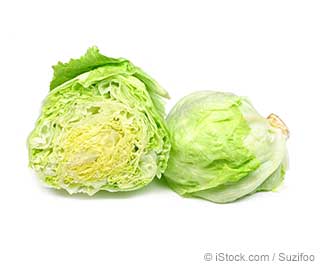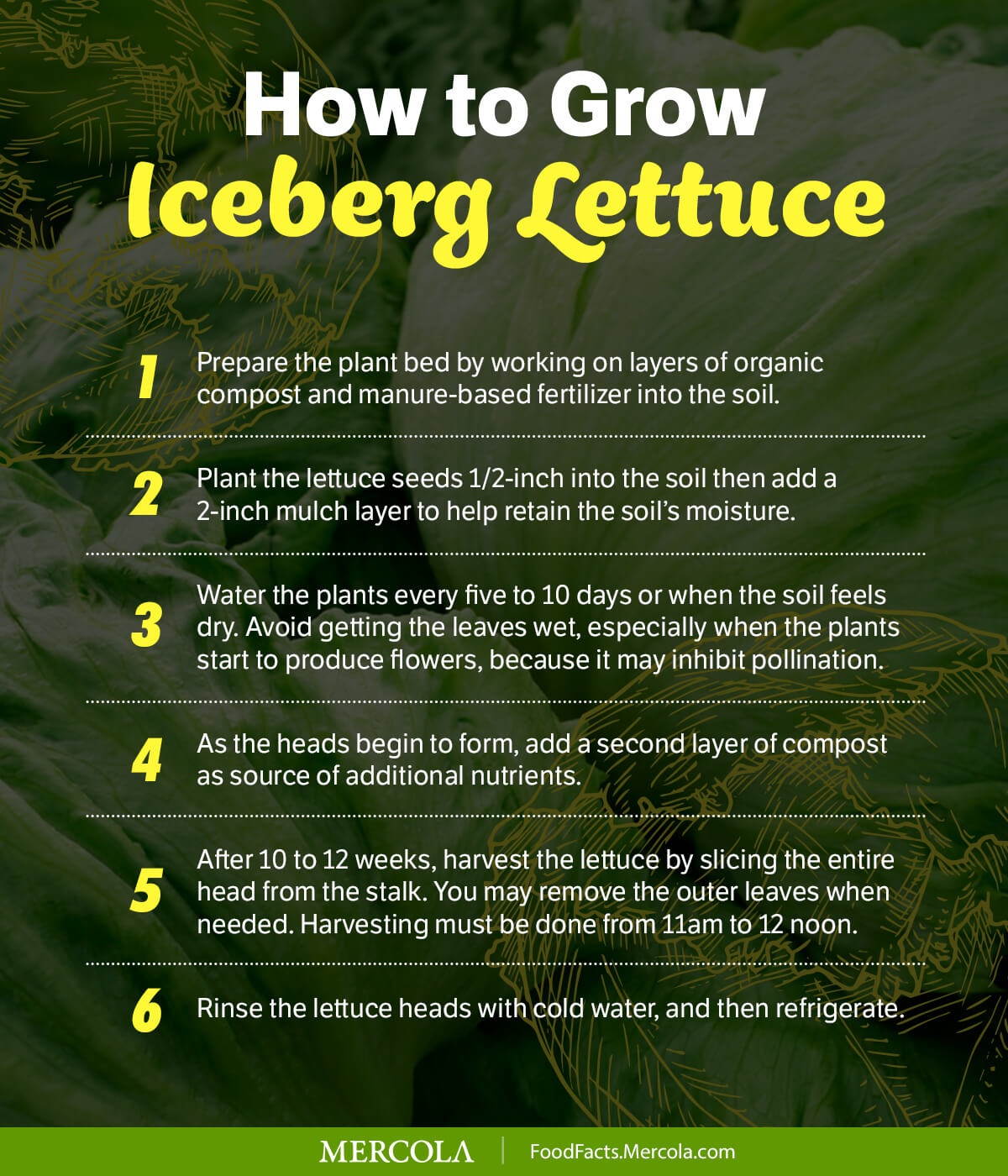Irresistible Iceberg
Botanical name: Lactuca sativa

Iceberg lettuce has been surrounded by various criticisms saying that it is one of the most “useless” vegetables in the culinary world. People have even claimed that iceberg lettuce is just as nutritious as cardboard.
This is probably because, compared to other varieties of lettuce, iceberg lettuce has a lower nutritional content.1 But to believe that it’s as useless as eating cardboard simply robs you of the nutritional benefits that it can actually offer you.
The iceberg lettuce was first introduced in the market in the late 1940s. It was the only variety of lettuce that survived travel without wilting mainly because it was transported by means of trucks filled with large amounts of ice, hence the name.
The decline in iceberg lettuce sales, however, started when people started shifting their focus to other varieties that have higher concentrations of vitamins and minerals.2
Although it has fewer vitamins and minerals than other lettuce varieties, iceberg lettuce is not at all useless and can actually have a place in your diet — here’s why.
Iceberg Lettuce Health Benefits: Not as Useless as You Think
If you find yourself asking, “Is iceberg lettuce good for you?”, the clear answer is yes. Here are some of the health benefits that you can get when you incorporate this lettuce variety into your diet:3,4,5
- May aid in weight loss — Iceberg lettuce has a low caloric content with only 75 calories per medium-sized head.
- May help reduce the risk of birth defects — This vegetable contains a considerable amount of folate, a mineral essential for protecting against birth defects and other prenatal conditions.
- Contains vitamins A and C — Even though it has the lowest percentage of vitamins A and C among all lettuce varieties, iceberg contains good amounts of these vitamins. Vitamin A has been commonly linked to eye maintenance and the prevention of macular degeneration, the leading cause of age-related blindness, while vitamin C has been observed to boost the body’s immune system through its antioxidant properties.
Note: While lettuce can potentially provide you with the benefits mentioned above, remember that they contain less nutrients than other leafy greens. Hence, it’s advisable not to rely solely on lettuce as your nutrient source and to instead mix them up with other vegetables such as microgreens or sprouts. Swapping lettuce for sprouts or microgreens will dramatically improve your nutrition and add more interesting flavors to your meal.
How Is Iceberg Lettuce Used in the Culinary World?
Among the vegetables available in the U.S., iceberg lettuce was the most consumed in the 1950s.6 In those days, when you order a salad in restaurants, it was certain that iceberg lettuce would be the main ingredient. However, when other green vegetables such as fresh spinach and arugula were introduced, its demand declined.7
But in recent years, iceberg lettuce has been making a comeback in the market. In American cuisine, this vegetable is now being used as a main ingredient in soups, appetizers and even main dishes. It has also been used as an alternative to shredded cabbage, offering a sweeter and milder flavor.8
How to Buy Good Iceberg Lettuce
Fresh greens make a salad great, right? You wouldn’t want to buy greens doused in preservatives, but how would you identify a fresh iceberg lettuce? Here are some things to remember and look for when buying iceberg lettuce:9,10,11,12
- According to Taste.com.au, you would know that a lettuce is fresh when its leaves are firm and it is dense.
- It must not have excess outer leaves and discolored spots that may indicate decay.
- It should be pale green in color, unlike other lettuce varieties that have darker hues.
- Avoid buying prewashed or triple-washed bagged lettuce. A 2005 study proved that these kinds undergo chlorine washes and are linked with E. coli bacteria contamination.
It would be better to buy from local stores rather than supermarkets not only to reduce your transport time but also to hinder the growth of bacteria over time. You may also consider growing your own lettuce plants to save time and energy, and to ensure its freshness and safety. Read further to know how to grow your own iceberg lettuce plants.
Try These Healthy and Tasty Iceberg Lettuce Recipes
Iceberg lettuce is most commonly found in salads because of its ability to complement other ingredients without overpowering or even masking the flavors. Chefs also note that iceberg lettuce adds additional crisp to a dish without compromising the dish’s overall taste.13 Here are some iceberg lettuce recipes that you can try if you’re craving that healthy and refreshing crunch:14,15
Iceberg, Lemon and Mint Slaw

|
Ingredients:
|
|
✓ 1 iceberg lettuce, coarsely shredded
|
✓ 5 green onions, thinly sliced
|
✓ 1 celery heart with leaves, thinly sliced
|
✓ 1 bunch mint leaves, coarsely chopped
|
|
✓ 1 lemon, juice and thinly sliced rind
|
✓ 1/4 cup coconut oil
|
✓ 1 teaspoon raw honey
|
|
Procedure:
- Combine lettuce, onions, celery heart and mint in a plastic container with a lid. Refrigerate for about six hours.
- For the dressing, place all of the ingredients in a screw-top jar. Season with Himalayan salt and pepper to taste. Seal and refrigerate the dressing. Shake and pour over salad.
(Adapted from Notebook, Taste.co.au)
Iceberg Wedges with Blue Cheese Dressing

|
Ingredients:
|
|
✓ 2 garlic cloves, crushed
|
✓ 150 ml sour cream
|
✓ 2 tablespoons homemade mayonnaise
|
✓ 1 teaspoon Dijon mustard
|
|
✓ 2 tablespoons coconut oil
|
✓ 1 tablespoon apple cider vinegar
|
✓ 1 tablespoon lemon juice
|
✓ 40 grams blue cheese
|
|
✓ 1 firm iceberg lettuce, cut into 6 wedges
|
✓ 2 tablespoons chopped fresh chives
|
|
|
Procedure:
- Place the garlic, sour cream, mayonnaise, mustard, coconut oil, apple cider vinegar, lemon juice and blue cheese in a food processor.
- Process for a few seconds until combined.
- Place a lettuce wedge on each serving plate. Drizzle with the dressing and garnish with the chopped chives. Serve as a starter or a side dish
(Adapted from Delicious, Taste.com.au)
Here’s How You Can Grow Your Own Iceberg Lettuce
If you’re planning to grow your own lettuce, you must first ensure that you live in a place with a cool climate. Iceberg lettuce and other varieties of this vegetable are usually grown in areas where the temperature does not exceed 60 degrees Fahrenheit. If the temperature goes any higher, lettuce plants may grow prematurely. Here’s a guide on planting and harvesting your own iceberg lettuce supply:16,17,18

Iceberg Lettuce Nutritional Facts
Considering that iceberg lettuce is commonly used in salads, the staple food for people who are trying to lose weight, it comes as no surprise that the calories in iceberg lettuce are relatively low. It contains about 10 calories per serving. This is usually attributed to the fact that about 96 percent of it is water. Here’s a list of the other nutrients that you can get from eating iceberg lettuce:19
Iceberg Lettuce Nutrition Facts
Serving Size: 100 grams
| Calories |
14 |
|
| Calories from Fat |
1 |
|
| Total Fat |
0 g |
0% |
| Saturated Fat |
0 g |
0% |
| Trans Fat |
|
|
| Cholesterol |
0 mg |
0% |
| Sodium |
10 mg |
0% |
| Total Carbohydrates |
3 g |
1% |
| Dietary Fiber |
1.2 g |
5% |
| Sugar |
2 g |
|
| Protein |
1 g |
|
| Calcium 2% |
Iron |
2% |
*Percent Daily Values are based on a 2,000 calorie diet. Your daily values may be higher or lower depending on your calorie needs.